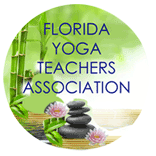FYTA hosted this workshop which was held on September 6 – 8, 2019 at the Garden Club of St. Petersburg.
The workshop was led by Beth Spindler, C-IAYT, ERYT. Beth is a practicing yoga therapist in the Greater New York Area. She writes and teaches for Yoga International Publications and offers workshops, training and seminars worldwide.
Florida Yoga Teachers Association is greatly appreciative of Beth’s invaluable insights. We’ll certainly want her to return! She has over four decades experience in utilizing yoga as a healing modality, plus the highest certification in the field. Her book, Yoga Therapy for Fear: Treating Anxiety, Depression and Rage with the Vagus Nerve and Other Techniques is recognized in the Yoga Therapy community as essential text for those studying in the field. She is a frequently featured writer and presenter for Yoga International. Beth leads retreats worldwide.
Beth is first and foremost a kind, generous human being with concern for students, teachers and the many folks affected by trauma. Beth knows that many suffer from PTSD, physical, emotional and sexual abuse, anxiety, depression and fear.
I didn’t know what to expect from Beth’s workshop beyond breathing techniques and tension-releasing asanas. (Now I’ve been watching Beth Spindler videos on YouTube.) Beth’s workshop opened my eyes to how observant and educated we yoga teachers need to be, focusing on not only safe asana practice, but also being keenly aware of how trauma effects people. Many, many people.
It’s estimated that over 50% of our students have suffered the trauma of physical, sexual or emotional, abuse. Yoga classes can raise our vulnerabilities. Facing and overcoming our sense of vulnerability is healing, but for many, pain and fear may be overwhelming, leading to avoidance of the practice.
Beth has taught for over 40 years. As a yoga therapist, she is focused on triggers that may cause fear and avoidance in people.
Common Triggers may be:
- Words and phrases:
- “May I touch you?” “Relax” “Calm down”
- Stillness at the beginning of class (can be a challenge to slow and quiet the unsettled mind)
- Certain poses:
- Balasana (Child pose)
- Adho Mukha Svanasana (Downward Facing Dog pose)
- Makarasana (Crocodile pose)
- Bharmanasana (Table Top pose)
- Position in class. Beth has learned that traumatized students prefer to be at the back of the room. One approach is to have students line the room around the instructor, back to the wall if possible. In other words, no one feels stressed by being in front of other students.
- Straps: One student told Beth, “That was my tourniquet.”
- Music: Veterans may be triggered by music from locations they’ve experienced. Likewise, victims of any trauma may be reminded of an intense experience when hearing certain sounds.
We are not just teaching poses. We are creating safe places. To quote the introduction of Beth’s book, Yoga Therapy for Fear:
It offers asana, pranayama and dhyana exercises that help to eliminate ‘worry chatter’ directly affecting the amygdala, the part of the brain responsible for fearful thoughts. Addressing many components of fear, the book explains when fear is useful and when it is not, and teaches how to reprogram responses to uncertain circumstances so that they can be dealt with in a healthy way.
Real yoga for everyone. Learn to teach everyone in your class.
Looking for a Yoga Teacher in Florida?
A qualified Yoga teacher in your area is ready to help guide you on your journey.
Visit here : https://floridayogateachers.org/

